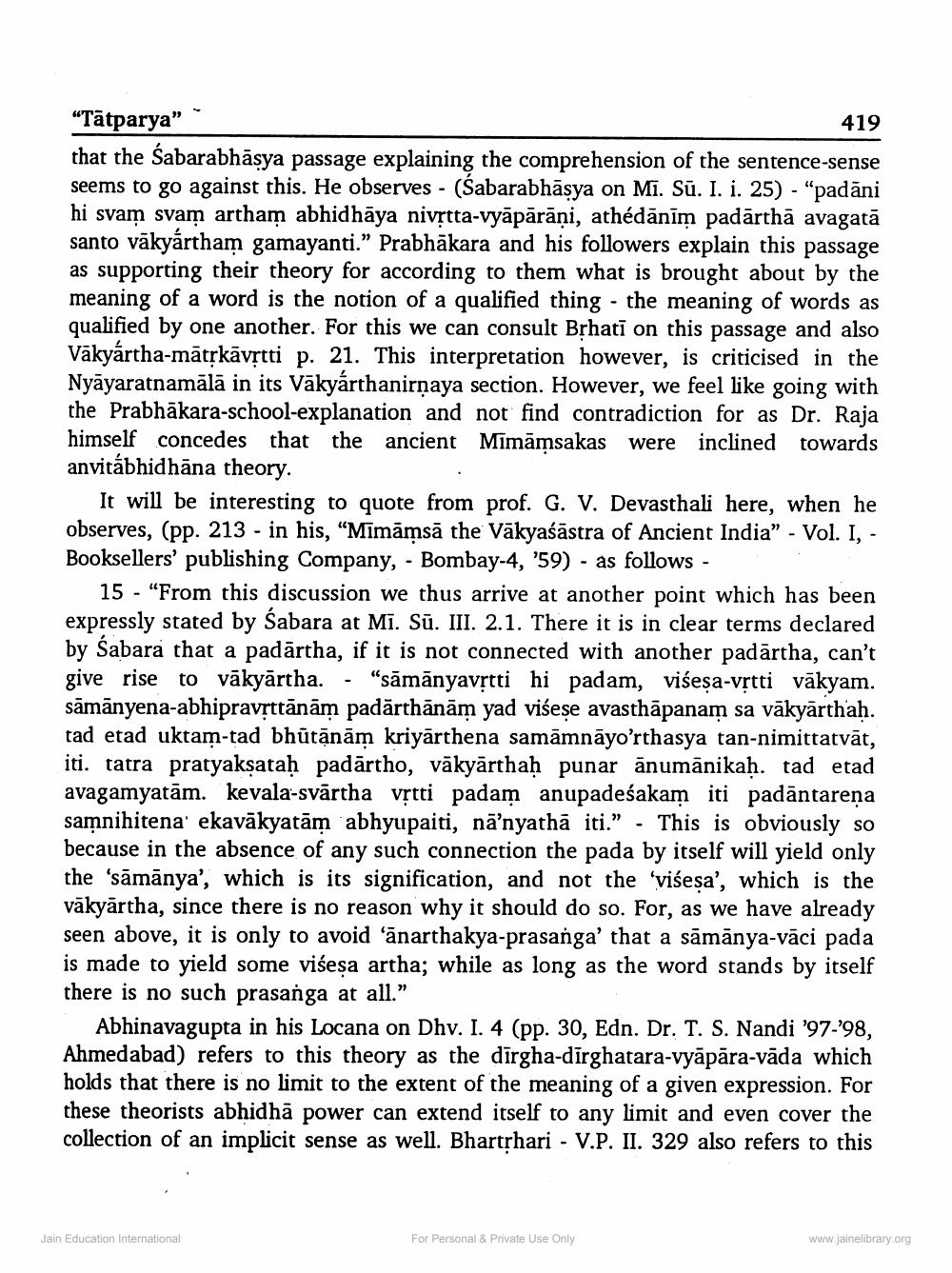________________
“Tātparya”
419 that the Sabarabhāsya passage explaining the comprehension of the sentence-sense seems to go against this. He observes - (Sabarabhāsya on Mi. Sū. I. i. 25) - "padani hi svam svam artham abhidhāya nivștta-vyāpārāņi, athédānīm padārthā avagatā santo vākyártham gamayanti.” Prabhākara and his followers explain this passage as supporting their theory for according to them what is brought about by the meaning of a word is the notion of a qualified thing - the meaning of words as qualified by one another. For this we can consult Brhati on this passage and also Vākyártha-mātrkāvrtti p. 21. This interpretation however, is criticised in the Nyāyaratnamālā in its Vakyárthanirnaya section. However, we feel like going with the Prabhākara-school-explanation and not find contradiction for as Dr. Raja himself concedes that the ancient Mimāmsakas were inclined towards anvitábhidhāna theory.
It will be interesting to quote from prof. G. V. Devasthali here, when he observes, (pp. 213 - in his, “Mimāmsā the Vākyaśāstra of Ancient India” - Vol. I, - Booksellers' publishing Company, - Bombay-4, '59) - as follows -
15 - "From this discussion we thus arrive at another point which has been expressly stated by Sabara at Mi. Sū. III. 2.1. There it is in clear terms declared by Sabara that a padārtha, if it is not connected with another padārtha, can't give rise to vākyārtha. - “sāmānyavrtti hi padam, viśeşa-vịtti vākyam. sāmānyena-abhipravsttānām padārthānām yad viśese avasthāpanam sa vākyārthah. tad etad uktam-tad bhūtānām kriyārthena samāmnāyo'rthasya tan-nimittatvāt, iti. tatra pratyaksataḥ padārtho, vākyārthaḥ punar anumānikah. tad etad avagamyatām. kevala-svārtha vrtti padam anupadeśakam iti padāntarena samnihitena ekavākyatām abhyupaiti, nā’nyathā iti." . This is obviously so because in the absence of any such connection the pada by itself will yield only the 'sāmānya', which is its signification, and not the 'visesa', which is the vākyārtha, since there is no reason why it should do so. For, as we have already seen above, it is only to avoid 'anarthakya-prasanga' that a sāmānya-vāci pada is made to yield some visesa artha; while as long as the word stands by itself there is no such prasanga at all.”
Abhinavagupta in his Locana on Dhv. I. 4 (pp. 30, Edn. Dr. T. S. Nandi '97-'98, Ahmedabad) refers to this theory as the dirgha-dirghatara-vyāpāra-vāda which holds that there is no limit to the extent of the meaning of a given expression. For these theorists abhidhā power can extend itself to any limit and even cover the collection of an implicit sense as well. Bhartrhari - V.P. II. 329 also refers to this
Jain Education International
For Personal & Private Use Only
www.jainelibrary.org




